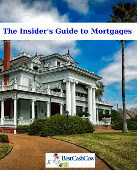Los Angeles, California 30-Year Fixed Conforming Mortgage
Average: 7.23% APR
| Lender | APR | Rate (%) | Monthly Payment? |
||||
|---|---|---|---|---|---|---|---|

Allied Mortgage Group, Inc. NMLS ID: 1067 |
6.686% 30 Yr Fixed |
6.625%
Fees & Points
$2,035 Total
0.636 Pts: $2,035 $0 Fees |
Learn More
See Table View |
||||

Bison State Bank NMLS ID: 757416 |
6.720% 30 Yr Fixed |
6.624%
Fees & Points
$3,178 Total
0.993 Pts: $3,178 $0 Fees |
Learn More
See Table View |
||||

Mutual of Omaha Mortgage, Inc. NMLS ID: 1025894 |
6.735% 30 Yr Fixed |
6.625%
Fees & Points
$3,625 Total
0.914 Pts: $2,925 $700 Fees |
Learn More
See Table View |
||||

GenNext.Mortgage NMLS ID: 2326098 License#: 60DBO-181478 |
6.763% 30 Yr Fixed |
6.625%
Fees & Points
$4,766 Total
0.879 Pts: $2,813 $1,953 Fees |
Learn More
See Table View |
||||

PenFed Credit Union NMLS ID: 401822 |
7.010% 30 Yr Fixed |
6.875%
Fees & Points
$4,395 Total
0.750 Pts: $2,400 $1,995 Fees |
Learn More
See Table View |
||||

Rocket Mortgage NMLS ID: 3030 |
7.689% 30 Yr Fixed |
7.625%
Fees & Points
$2,000 Total
0.625 Pts: $2,000 $0 Fees |
Learn More
See Table View |
||||

Veterans United Home Loans NMLS ID: 1907 |
|
Learn More
|
|||||
|
Rate data provided by RateUpdate.com. Displayed by ICB, a division of Mortgage Research Center, NMLS #1907, Equal Housing Opportunity. Payments do not include taxes, insurance premiums or private mortgage insurance if applicable. Actual payments will be greater with taxes and insurance included. Click here for more information on rates and product details. |
|||||||
|
U.s. Bank National Association Updated 05/07/2023 |
6.27% |
6.13%
0.63 points $0.00 fees |
$1,944.35 |
See Table View |
|||
|
Updated 04/11/2025 |
7.06% |
6.25%
1.88 points $3,210.00 fees |
$1,969.25 |
See Table View |
|||
|
Wells Fargo Bank, National Association Updated 09/27/2024 |
5.82% |
6.33%
0.00 points $0.00 fees |
$1,986.77 |
See Table View |
|||
|
Updated 11/17/2023 Restrictions |
7.25% |
6.36%
0.00 points $0.00 fees |
$1,992.83 |
See Table View |
|||
|
Updated 02/28/2024 |
6.47% |
6.38%
0.00 points $0.00 fees |
$1,996.38 |
See Table View |
|||
|
Bank Of America, National Association Updated 05/07/2023 |
6.86% |
6.63%
0.86 points $0.00 fees |
$2,049.00 |
See Table View |
|||
|
Updated 06/15/2022 |
7.00% |
6.88%
0.00 points $4,876.00 fees |
$2,102.17 |
See Table View |
|||
|
Updated 06/15/2022 Restrictions |
6.99% |
6.88%
0.00 points $2,784.00 fees |
$2,103.24 |
See Table View |
|||
|
Updated 05/17/2024 |
6.88% |
7.00%
1.13 points $0.00 fees |
$2,129.61 |
See Table View |
|||
|
Updated 11/01/2024 Restrictions |
7.21% |
7.09%
0.00 points $0.00 fees |
$2,148.34 |
See Table View |
|||
|
Educational Employees Credit Union Updated 06/15/2022 Restrictions |
7.17% |
7.13%
0.00 points $0.00 fees |
$2,155.90 |
See Table View |
|||
|
Navy Federal Credit Union Credit Union Updated 01/30/2023 Restrictions |
7.43% |
7.25%
0.75 points $0.00 fees |
$2,182.96 |
See Table View |
|||
|
Updated 06/15/2022 Restrictions |
7.30% |
7.25%
0.00 points $0.00 fees |
$2,182.96 |
See Table View |
|||
|
Updated 02/06/2023 Restrictions |
7.52% |
7.38%
-0.13 points $0.00 fees |
$2,210.16 |
See Table View |
|||
|
Updated 06/15/2022 Restrictions |
7.44% |
7.38%
0.00 points $0.00 fees |
$2,210.16 |
See Table View |
|||
|
Updated 06/15/2022 Restrictions |
7.52% |
7.38%
0.13 points $2,784.00 fees |
$2,211.25 |
See Table View |
|||
|
Updated 06/15/2022 Restrictions |
7.51% |
7.50%
0.00 points $0.00 fees |
$2,237.49 |
See Table View |
|||
|
Updated 06/15/2022 Restrictions |
7.52% |
7.50%
0.00 points $0.00 fees |
$2,237.49 |
See Table View |
|||
|
Citizens Equity First Credit Union Updated 06/15/2022 Restrictions |
7.51% |
7.50%
0.00 points $2,936.00 fees |
$2,237.49 |
See Table View |
|||
|
Updated 08/11/2023 |
7.57% |
7.57%
0.00 points $0.00 fees |
$2,251.97 |
See Table View |
|||
|
Data provided by BestCashCow |
|||||||
1 Rate data provided by RateUpdate.com. Displayed by ICB, a division of Mortgage Research Center, NMLS #1907, Equal Housing Opportunity. Payments do not include taxes, insurance premiums or private mortgage insurance if applicable. Actual payments will be greater with taxes and insurance included. Click here for more information on rates and product details.
Rates from this table are based on loan amount of $320,000 and a variety of factors including credit score and loan to value ratios. Rates may change at any time and are not guaranteed to be correct. For specific requirements please check with the lender.


